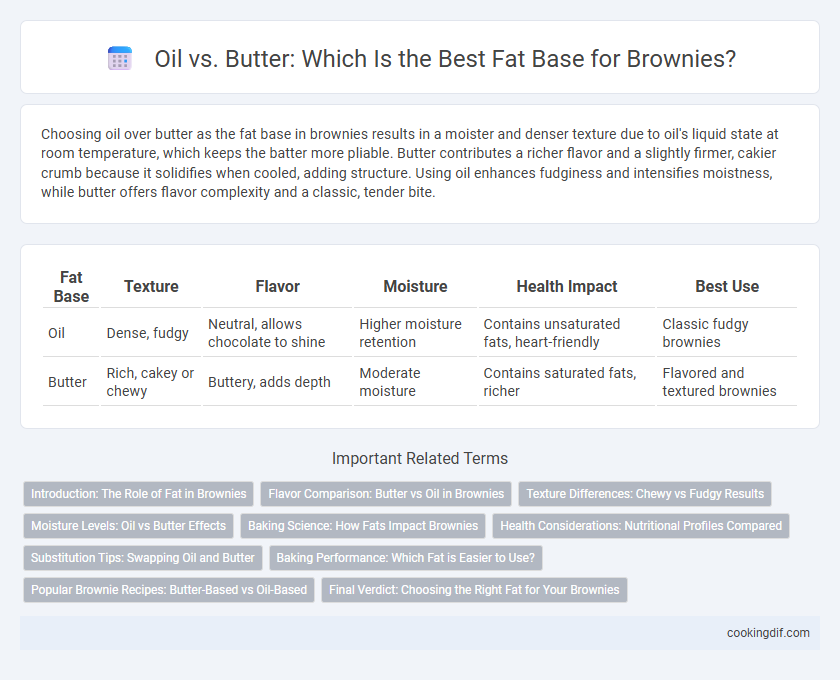Choosing oil over butter as the fat base in brownies results in a moister and denser texture due to oil's liquid state at room temperature, which keeps the batter more pliable. Butter contributes a richer flavor and a slightly firmer, cakier crumb because it solidifies when cooled, adding structure. Using oil enhances fudginess and intensifies moistness, while butter offers flavor complexity and a classic, tender bite.
Table of Comparison
| Fat Base | Texture | Flavor | Moisture | Health Impact | Best Use |
|---|---|---|---|---|---|
| Oil | Dense, fudgy | Neutral, allows chocolate to shine | Higher moisture retention | Contains unsaturated fats, heart-friendly | Classic fudgy brownies |
| Butter | Rich, cakey or chewy | Buttery, adds depth | Moderate moisture | Contains saturated fats, richer | Flavored and textured brownies |
Introduction: The Role of Fat in Brownies
Fat plays a crucial role in brownies by providing moisture, richness, and tenderness essential for achieving the desired fudgy texture. Butter contributes a rich, creamy flavor and aids in aeration when creamed with sugar, resulting in a denser, more flavorful brownie. Oil, with its liquid consistency at room temperature, produces a moister and softer crumb, making it ideal for chewy, cake-like brownies.
Flavor Comparison: Butter vs Oil in Brownies
Butter imparts a rich, creamy flavor and a slightly caramelized taste to brownies due to its milk solids and water content, enhancing the overall depth and complexity. Oil, being neutral and flavorless, allows other ingredients like cocoa and sugar to shine, resulting in a more straightforward chocolate flavor. Choosing butter over oil intensifies the buttery richness, while oil produces a moist texture with a cleaner chocolate profile.
Texture Differences: Chewy vs Fudgy Results
Using oil as the fat base in brownies creates a moist, dense texture that yields a fudgy result, while butter produces a richer flavor with a slightly crumbly, chewy texture. Oil's liquid consistency prevents the brownies from drying out, enhancing their fudginess, whereas butter's solid fat contributes to structure and a more pronounced crumb. Adjusting the fat base directly influences the mouthfeel, with oil emphasizing moistness and butter emphasizing chewiness in the final brownie.
Moisture Levels: Oil vs Butter Effects
Oil-based brownies retain higher moisture levels, resulting in a denser, fudgier texture due to oil's liquid state at room temperature. Butter adds richer flavor but can make brownies slightly drier as it solidifies when cooled, trapping less moisture. Choosing oil enhances moistness, while butter contributes to flavor depth and a firmer crumb.
Baking Science: How Fats Impact Brownies
Oil creates brownies with a moist, tender crumb due to its liquid state at room temperature, resulting in increased fat dispersion and moisture retention. Butter contributes a rich flavor and firmer texture because it contains water and milk solids that promote better structure and caramelization during baking. Understanding the melting points and composition of fats helps optimize brownie texture, balancing softness and chewiness based on desired outcomes.
Health Considerations: Nutritional Profiles Compared
Choosing oil as the fat base for brownies provides unsaturated fats that support heart health, while butter contains higher levels of saturated fats that may raise cholesterol. Oil-based brownies often have fewer calories and less cholesterol, making them a better option for those monitoring cardiovascular risk. Butter adds rich flavor and texture but should be consumed in moderation to balance taste with health benefits.
Substitution Tips: Swapping Oil and Butter
Butter provides a rich, creamy texture and enhances the flavor of brownies, while oil contributes to a moist and dense crumb. When substituting butter for oil, use a 1:1 ratio but melt the butter first to maintain consistency. Replacing butter with oil requires reducing the oil quantity by about 20% to avoid excessive greasiness and adjusting baking times slightly for optimal results.
Baking Performance: Which Fat is Easier to Use?
Butter provides a rich flavor and creates a tender, flaky texture in brownies due to its solid fat content that incorporates air when creamed. Oil, being liquid at room temperature, offers ease of mixing and produces moist, dense brownies with less effort and fewer mixing steps. Bakers seeking convenience and consistent moisture often find oil easier to use, while those prioritizing flavor and texture prefer butter despite its slightly more complex handling.
Popular Brownie Recipes: Butter-Based vs Oil-Based
Butter-based brownies are favored in popular recipes for their rich, creamy texture and deep, indulgent flavor, often resulting in a denser, fudgier bite. Oil-based brownies tend to be moist and tender with a lighter crumb, appealing to those who prefer a softer, cake-like consistency. The choice between butter and oil significantly influences the final flavor profile and texture, with butter enhancing richness and oil providing a subtle, neutral taste.
Final Verdict: Choosing the Right Fat for Your Brownies
Butter imparts a rich, creamy flavor and a tender crumb to brownies, enhancing texture with its milk solids and water content. Oil produces fudgier, denser brownies with a moist consistency due to its 100% fat composition, ideal for intensifying chocolate richness. Selecting butter delivers classic taste and structure, while oil suits those seeking moistness and a softer bite, making the choice dependent on desired brownie texture and flavor profile.
Oil vs Butter for brownie fat base Infographic

 cookingdif.com
cookingdif.com